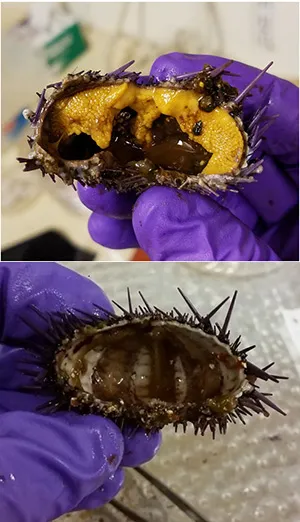Kelp forests off the coast of California have declined dramatically since 2014, with large areas being replaced by a carpet of sea urchins. However, there are often healthy patches of forest next door – and a study from the University of California, Santa Cruz has shown that it’s sea otters’ green paws that help them thrive.
Sea otters are a ‘keystone species’: they play a disproportionately important role in their ecosystem, influencing the populations of the plants and animals that live there. In particular, they protect kelp forests by preying on sea urchins.
Two separate environmental factors have been taking a harsh toll on California’s kelp forests. An unprecedented marine heatwave known as ‘the Blob’ hit the Northeast Pacific in 2014, at the same time as the unusually warm ocean conditions known as El Niño came up from the south.
Kelp grow best in cold, nutrient-rich water. Giant kelp is one of the world’s fastest-growing organisms, and in ideal conditions can grow up to around 60 cm in a single day. But with the heat from the Blob and El Niño, the kelp’s growth rate dropped dramatically.
A further threat to the kelp began a year earlier. In 2013, a mysterious disease known as sea star wasting syndrome swept through the starfish of the West Coast of North America. The sunflower sea star (Pycnopodia helianthoides) in particular, a major sea urchin predator, was hit by the disease.
Read more about animal behaviour:
- Cuttlefish exercise self-control, demonstrating link between willpower and intelligence
- Frogs use their lungs like noise-cancelling headphones to find mates
- Why do flamingos stand on one leg?
The combination of these two factors led to an outbreak of sea urchins. In kelp forests, sea urchins usually live in rocky crevices where they are sheltered from predators, feeding on pieces of kelp detritus that float down towards the seabed. But when kelp stopped growing so quickly – and so shed less detritus – the urchins were forced to leave their safe havens to find food. And since the threat of starfish had been decimated, the sea urchins were free to eat as much kelp as they liked.
"It happened so fast, before we knew it we had lost over 80 per cent of the historic kelp forest cover in Northern California," said graduate student Joshua Smith, co-author of the study published in Proceedings of the National Academy of Sciences. "We also had an urchin outbreak on the Central Coast, but not to the same extent as in the areas north of San Francisco."
The result was ‘urchin barrens’: areas of seafloor that were once covered in kelp forest, but are now carpeted with sea urchins. However, these areas were interspersed with areas of relatively healthy kelp forest. To find out why, Smith and a team of sea otter researchers at UCSC, the US Geological Survey, and the Monterey Bay Aquarium surveyed sea otter populations and kelp forest ecosystems for three years.

"Here in Monterey Bay, we now have a patchy mosaic, with urchin barrens devoid of kelp directly adjacent to patches of kelp forest that seem pretty healthy," Smith said. "We wanted to know how did this sea urchin outbreak happen where there are so many otters, how did the otters respond, and what does that mean for the fate of kelp forests here on the Central Coast?"
In response to the explosion in sea urchin population, sea otters ate around three times as many urchins than they had before 2014. Sea otter population also exploded, from around 270 to 432 in the Monterey region at the southern end of Monterey Bay.
However, the otters weren’t eating sea urchins from the urchin barrens: only from the kelp forests. Urchins from the kelp forests are rich in nutrients compared to their starved neighbours in the barrens.

"Some people call them zombie urchins," Smith said. "You open them up, and they're empty. So the otters are ignoring the urchin barrens and going after the nutritionally profitable urchins in the kelp forest." As a result, the otters are helping to maintain healthy areas of kelp forest.
However, this won’t help the urchin barrens to recover. The researchers say that this will require another urchin predator, or a disease or heavy storm to disrupt the barrens. Once this happens, spores from the healthy forests could reseed the seabed.
"This study not only fine tunes our understanding of the role of sea otters in kelp forests, it also emphasises the importance of animal behaviour," Smith said. "So much of this is driven by behaviour – the urchins shifting their behaviour to active foraging, and the otters choosing to prey on healthy urchins in the kelp forest – and these behavioural interactions have implications for the overall fate of the ecosystem."